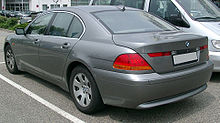Chris Bangle
Christopher Edward Bangle (born October 14, 1956 in Ravenna , Ohio ) is an American product designer who was mainly active in European automotive design until 2009. From 1992 to 2009 he was with BMW . He lives and works in Italy.
Life
From 1975 to 1977, Bangle studied fine arts at the University of Wisconsin . This was followed by training as an automotive designer at the Art Center College of Design in Pasadena , USA.
In 1981, at the age of 25, he took up his first position in Europe as an interior designer at Adam Opel AG in Rüsselsheim and in 1983 became deputy head of the interior design studio. In 1985 he moved to Fiat's Centro Stile in Turin, where he worked under the direction of Ermanno Cressoni . There he was appointed director of the design studio in 1992. At the end of 1992, Wolfgang Reitzle, then Head of Development, brought him to BMW as Head of Design .
In 2007, Chris Bangle won the honorary title Red Dot: Design Team of the Year as head of the BMW Group Design Team . His “GINA Vision” - abbreviation for “Geometry and functions in N-fold form” - is worth seeing - the outlook into the future of the automobile: automobiles without a body shell, which are flexible and can also be customized without any problems.
Bangle handed over management of BMW Group Design to Adrian van Hooydonk on March 1, 2009 and left the company. Van Hooydonk has been head of the brand design studio for BMW automobiles under Bangle since 2004 and is the designer who actually designed the 7 Series (E65) and 6 Series (E63 / 64) model series, which were controversially discussed in the media when they were introduced, and especially Chris Bangle were attributed.
After he left BMW in 2009, he and his wife Catherine founded the design company Chris Bangle Associates, which is based on a former agricultural estate in Clavesana, northern Italy. The company's clients include Samsung and Hennessy .
Bangle is considered one of the most influential car designers in the world. He has a son and lives in Italy with his wife.
Drafts and works
The following automobiles were created under the leadership of Chris Bangle:
- Fiat Coupé (interior design by Pininfarina )
- BMW Z3 (E36, 1996-2002)
- BMW 7 Series (E38, 1994-2001)
- BMW 3 Series (E46, 1998-2005)
- Rover 75 (R40, from 1998-2005)
- BMW X5 (E53, 1999-2006)
- BMW 7 Series (E65 / 66/67/68, 2001-2008)
- MINI (R50 / 52/53, 2001-2006)
- Range Rover (L30, from 2002)
- BMW Z4 (E85 / 86, 2002-2008)
- Rolls-Royce Phantom (RR01, from 2003)
- BMW X3 (E83, from 2003)
- BMW 5er (E60 / 61, from 2004)
- BMW 6er (E63 / 64, from 2004)
- BMW 1er (E81 / 82/87/88, from 2004)
- BMW 3er (E90 / 91/92/93, from 2005)
- BMW X5 (E70, from 2006)
- MINI (R55 / 56/57, from 2006)
- Rolls-Royce Phantom Drophead Coupé (RR2, from 2007)
- BMW X6 (E71, from 2008)
- Rolls-Royce Phantom Coupé (RR3, from 2008)
- BMW 7er (F01 / 02, from 2008)
- BMW Z4 (E89, from 2009)
- BMW 5 Series Gran Turismo (F07, from 2009)
Design studies and concept cars:
- Opel Junior (small car study 1983 by Opel )
- MINI ACV 30 (1997, design study for the new MINI )
- BMW Z9 gran turismo (1999, design study for the later BMW 6 Series )
- BMW Z9 Cabriolet (2000, design study for the later BMW 6 Series Convertible )
- BMW X Coupé (2001, design study on the design language of the later BMW Z4 )
- BMW CS1 (2002, design study for the later BMW 1 series)
- BMW xActivity (2003, design study for the later BMW X3 )
- MINI Concept Frankfurt (2005, design study for the MINI Clubman )
- MINI Concept Detroit (2006, design study for the MINI Clubman )
- Rolls-Royce 101EX (2006, design study for the Rolls-Royce Phantom Coupé )
- MINI Concept Geneva (2006, design study for the MINI Clubman )
- BMW Concept Coupe Mille Miglia (2006, technology study and homage to the BMW 328 Mille Miglia, 1936)
- BMW Concept CS (2007, design study for a luxury travel coupe / Gran Turismo)
- BMW M1 Hommage (2008, design study / homage for the 30th birthday of the BMW M1)
- BMW Concept X1 (2008, design study for the BMW X1 )
- BMW Concept 5 Gran Turismo (2009, design study for the BMW 5 Series Gran Turismo (ex Progressive Activity Sedan))
- BMW Gina Light Visionary Concept (2008, Geometry and Function in N Adaptions)
Criticism of his work at BMW
Since joining BMW in 1992, Chris Bangle has become known as an extremely controversial automotive designer. BMW customers and employees often criticize his work as exaggerated futurism and accuse him of a lack of harmony in his designs. In particular, many of the rear views he designed met with widespread rejection.
Above all, the BMW model of the 7 series (model E65 / 66) presented in 2001 was generally received negatively, especially because of the "rump" on the rear. As a result, expressions like Bangleheck , Banglekofferraum , Bangle butt and Bangledesign became popular words and were synonymous with bad design. There was even a petition on the Internet to stop Bangle. Mockers already translated “BMW” as “Bangle must go”.
Bangle himself explains the "Bangleheck" in retrospect by saying that as a result of new crash test regulations, the front of the cars had to be designed significantly higher than previously usual, so that the designers at BMW had the problem that the rear of the car had to be adjusted accordingly had to become. The additional optical lid on the actual trunk lid was the most obvious solution to this design problem, which he already knew back then that the competition would have to solve in the same way. Bangle said that the BMW design solutions criticized at the time were radical, but at the same time they were often copied over time.
literature
- The man for curves and edges - Chris Bangle, Head of Design at BMW . In: Die Zeit , No. 31/2002
Web links
- Departure of star designer Chris Bangle - Bye bye, BMW . In: Spiegel Online - Auto
- about the petition in: Spiegel Online - Auto
- Video about the "GINA Vision" on YouTube
- Chris Bangle at work on YouTube
- BMW Designers (English)
- Website of the design company Chris Bangle Associates (after 2009)
- Designer Edition by Chris Bangle (English) with Swarovski (2018)
Individual evidence
- ↑ Forgotten prototypes (V) - Freed from conventions - The BMW concept vehicle Gina Light was Chris Bangle's parting present after a mixed time as chief designer. The study with a flexible outer skin still shapes the design language at BMW today , by Herbie Schmidt, NZZ of December 11, 2014
- ↑ BMW AG press release of February 3, 2009
- ↑ BMW AG press release of February 3, 2004 ( page no longer available , search in web archives )
- ↑ Chris' Bio on the Chris Bangle Associates srl corporate website, accessed March 8, 2017
- ↑ Chris Bangle - Let's Talk About on YouTube
- ↑ Hennessy VSOP New Bottle Design by Chris Bangle on YouTube
- ↑ Chris Bangle: "A car design is frozen time" ZEIT Knowledge No. 2/2017, February 21, 2017, online March 7, 2017, accessed March 8, 2017
- ↑ faz.net from 2007, What is so ugly about the BMW M
- ↑ a b Chris Bangle: A man with a vision on cars and design on YouTube
| personal data | |
|---|---|
| SURNAME | Bangle, Chris |
| ALTERNATIVE NAMES | Bangle, Christopher Edward |
| BRIEF DESCRIPTION | American vehicle designer |
| DATE OF BIRTH | October 14, 1956 |
| PLACE OF BIRTH | Ravenna , Ohio |

